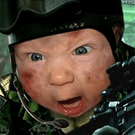I am making slow progress moving an app I have written using Apple’s SceneKit to Urho3D.
I’m having problems getting particle systems to do the same thing in Urho3D as I do in SceneKit.
The app is a visualization of our galaxy. I use particle systems for the galactic bulge and the stars and duct that make up the disk.
This movie shows what the app looks like in SceneKit.
This shows where I’m currently at in Urho3D.
I have several concerns (I can include any code upon request):
- I don’t seem to be able to change the color or alpha of the particle system. In the SceneKit version I change these thing subtly on the fly as you pan around. As far as I can tell the ParticleEffect class doesn’t have a color property (although the documentation implies it does).
I’ve tried setting the “color” tag in the xml, but it has no effect. If this worked, I could change the color and alpha as needed.
-
If you look at the Urho3D movie, obviously there is something wrong with the drawing order or the merging of the galaxy node and the bulge particle system. Any thoughts on that?
-
I also need to be able to change the alpha of the galaxy node on the fly. Is that possible?



